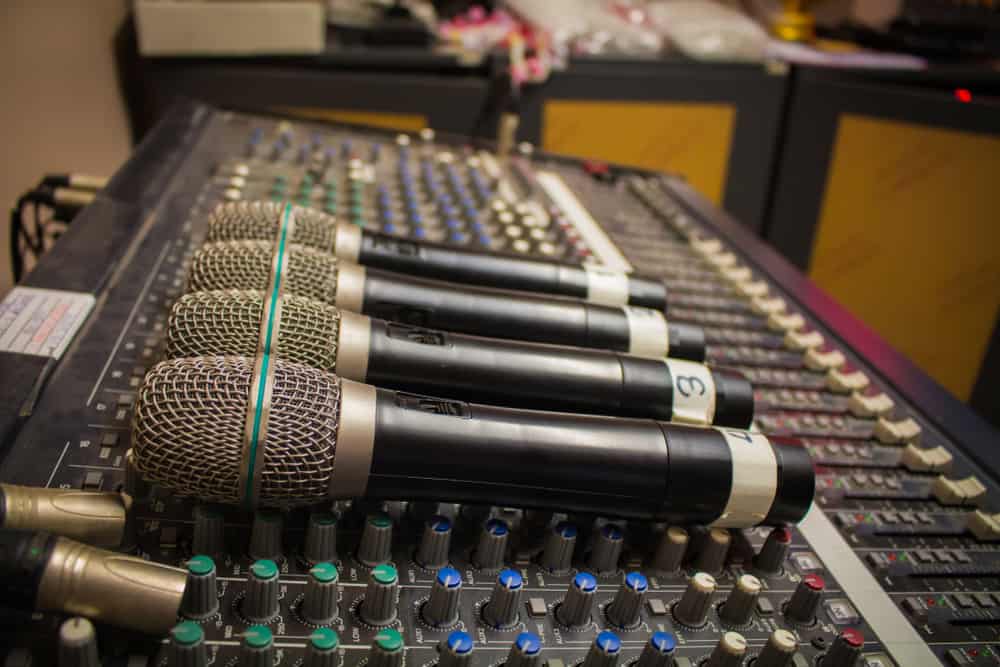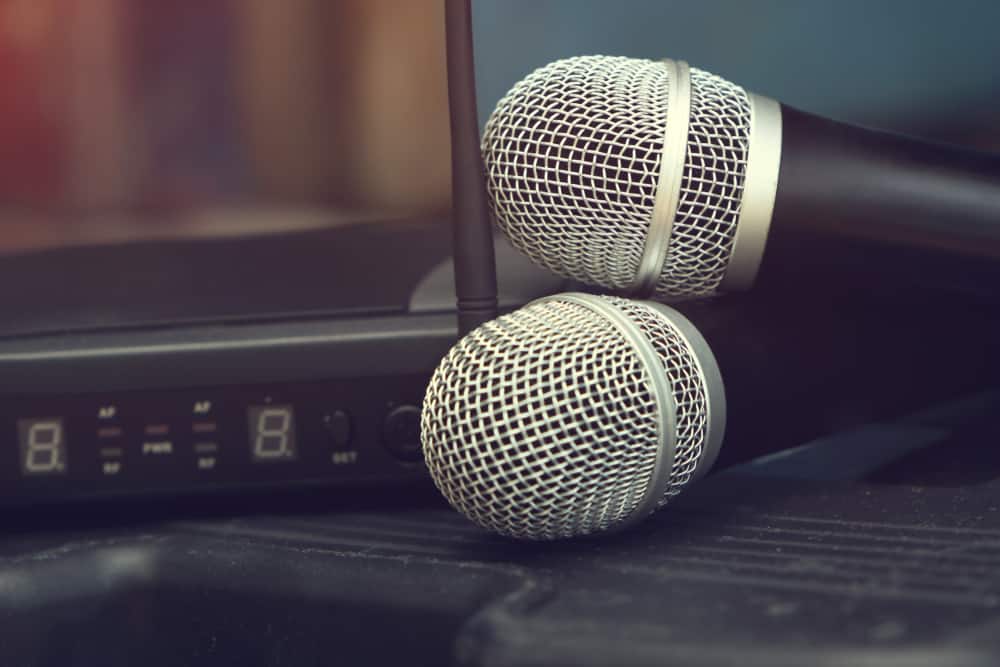
It is all good and well wanting to have a wireless microphone so you can run around on and off the stage. But what about powering the microphone? Some mics require 48 volts of phantom power to work correctly, and surely a couple of small alkaline batteries are not enough, but they power the mic, right?
Wireless mics are typically dynamic microphones, and these do not require phantom power to work correctly. Even condenser mics, lavalier mics, or head mics that plug into a bodypack do not use phantom power to drive their built-in pre-amps—the batteries for wireless mics and bodypacks power the transmitter for them to send the wireless audio signal.
This article will detail what phantom power is and how its works, and then it will consider the different types of microphones and how they work, including which ones require phantom power. We will then determine which type of microphones a wireless mic is, and with that understanding, we can determine whether or not wireless mics need and can actually produce phantom power.
Understanding phantom power
Phantom power is an industry-standard that enables us to transmit DC voltage over an audio cable. It allows us to provide power to professional audio equipment. It is called and known as phantom power because it works by carrying power over the same cable that carries the audio signal.
Hence the audio cable in question (typically an XLR cable) will provide simultaneous power and carry an audio signal to and from the equipment (in most cases, microphones). Phantom power is typically used to power the electronics in a microphone as well as the small preamp located in the microphone capsules. Other audio devices such as DI boxes and preamplifiers can also use phantom power.
Phantom power supplies are frequently built into microphone preamplifiers, commercial mixer amplifiers, and professional mixing desks. However, it is possible to purchase stand-alone phantom power supplies that can provide your audio equipment with phantom power. Well, why would you get stand-alone phantom power supplies if they com already built-in to the audio equipment?
In some cases, audio equipment will not support a phantom power supply because it is difficult to integrate into the audio equipment, or it will make the equipment more expensive than it is manufactured to be. Most audio equipment with built-in phantom power will typically provide power in the range of 12 to 48 volts. The power will run through a balanced XLR connection point.
In some instances, a microphone will only need 9 volts of phantom power, and thus you will be able to use a 1/4 inch jack connector rather than an XLR. Professional microphones that do require phantom power should show their required voltage range within the product specifications.

Understanding microphones
We use two types of microphones today for live and studio applications, and they are namely dynamic microphones and condenser microphones. Dynamic microphones typically do not require phantom power because their inner workings do not contain active circuitry. It is also important to note that supplying a dynamic microphone with phantom power will not damage its internal circuitry. This is only relevant to balance dynamic microphones. In some cases with unbalanced dynamic microphones, phantom power will affect the inner workings of the mic.
Condenser microphones are special microphones typically used in a studio application. Their inner workings will have active circuitry that requires electricity and a built-in preamp that will also require electricity. These are the types of microphones that will require direct phantom power for them to work correctly. Take note that the phantom power voltage will differ from microphones to microphone.
Which types of microphones are wireless?
In all scenarios, a wireless microphone will be a dynamic microphone. This means it will not have active circuitry in order for it to work correctly. So why do wireless microphones have batteries, then you may ask? Well, the batteries in a wireless microphone are there to power the transmitter and not the microphone itself. The audio signal has to be sent wireless to the receiving device, right? Hence the batteries in a wireless microphone power the built-in transmitter in order to send the audio signal to be transmitted through the air to the receiving device.
Do wireless mics need or use phantom power?
We already discussed that wireless mics use batteries to operate the transmitter but do they require phantom power. Due to the fact that wireless mics are dynamic microphones and only condenser microphones require phantom power to power their inner circuitry and preamp, a wireless dynamic microphone will not need or require phantom power.
Furthermore, you have to understand that phantom power sends a DC voltage of up to 48 volts to a microphone or a piece of audio equipment. There is no way that the small alkaline batteries that power the transmitter in a wireless microphone could ever sufficiently power a microphone with enough power. Hence, this is why there is phantom power and why it runs over a balanced cable.
If a couple of alkaline batteries could supply phantom power, there would be no need for it to exist in the first place.
What about wireless body packs? dont they have phantom power?
There are condenser microphones, lavalier microphones, and head-worn microphones that plug into a bodypack, and that bodypack then transmits the audio signal wirelessly to the receiving device, and many individuals think that the bodypack has phantom power; otherwise, how could the microphones work?
These microphones work because many of the microphones that are meant to be directly inserted into the bodypacks do not use their built-in preamp that will be required when used in wired situations.
The bodypack utilizes alkaline batteries or is rechargeable and, thus, will not have enough power to support the amount needed to run the inner circuitry of these microphones correctly. Thus the batteries or charging packs will again be there only to transmit the audio signal and nothing else.
Are wireless microphones better than wired microphones?
In all instances of audio, whether you are in a live or studio application, the best possible way to transmit (send and receive) an audio signal is via a wired connection and a balanced wired connection on top of that. Even when running an unbalanced wired connection, there is a disadvantage because the cables are susceptible to noise and interference where a balanced cable is not.
To understand what balanced and unbalanced cables are, you should check out my other articles here, where I cover everything you need to know about these types of audio cables.
You have to understand that if even a wired unbalanced cable is susceptible to noise and interference, then wireless audio signals are also susceptible to factors such as noise and interference, if not more so. Distance and obstacles can also affect the wireless audio transmission, and if the signal is obstructed in any way, there may be a loss of signal. There is no reason ever to even consider using a wireless mic in a studio application unless you only have that at your disposal.
Conclusion
We discovered we need to understand what phantom power is and which types of microphones use them, and why. Phantom power is electricity that powers microphones that require it to operate their internal circuitry and, in all cases, their built-in preamplifiers. These types of microphones are always condenser microphones.
Microphones that do not require phantom power, i.e., do not need power to get them to work correctly, are dynamic microphones. Dynamic microphones will be the microphones manufactured to be wireless and not condenser microphones.
Even though you may get condenser microphones that plug into a bodypack and are also wireless, these types of mics will not utilize their built-in preamp and thus will not require phantom power.
There is no scenario where the batteries of wireless microphones or bodypacks have enough power to supply microphones with phantom power. You have to remember that phantom power, in some cases, sends 48 volts of power in order to make a piece of audio equipment function correctly.
Hence, the batteries in a microphone or bodypack are there to power the wireless transmitter in order for it to send the audio signal through the airwaves (wirelessly) to the receiver. Lastly, it is always better to use a wired mic where possible because the quality of the signal will always be superior to that of a wireless audio signal.
Source list
Do Wireless Bodypacks Have Phantom Power?
